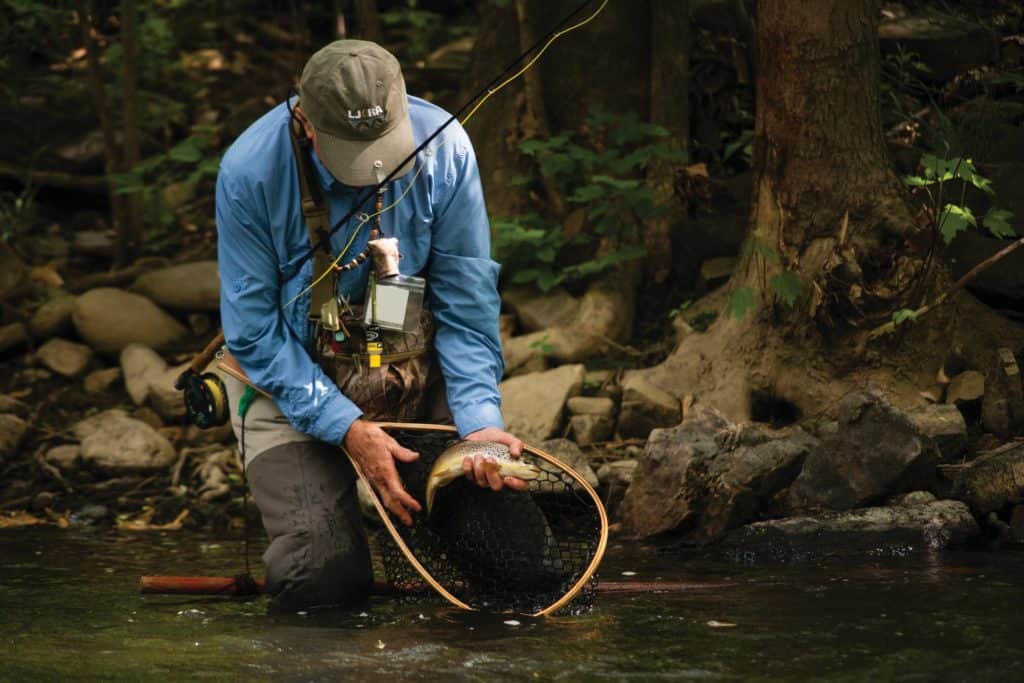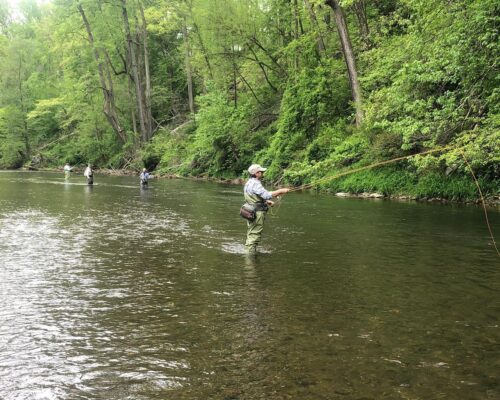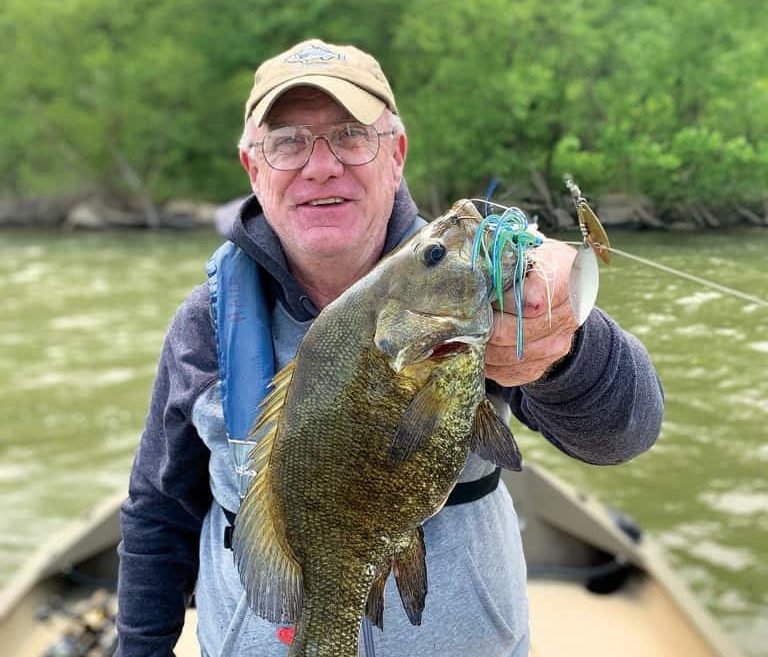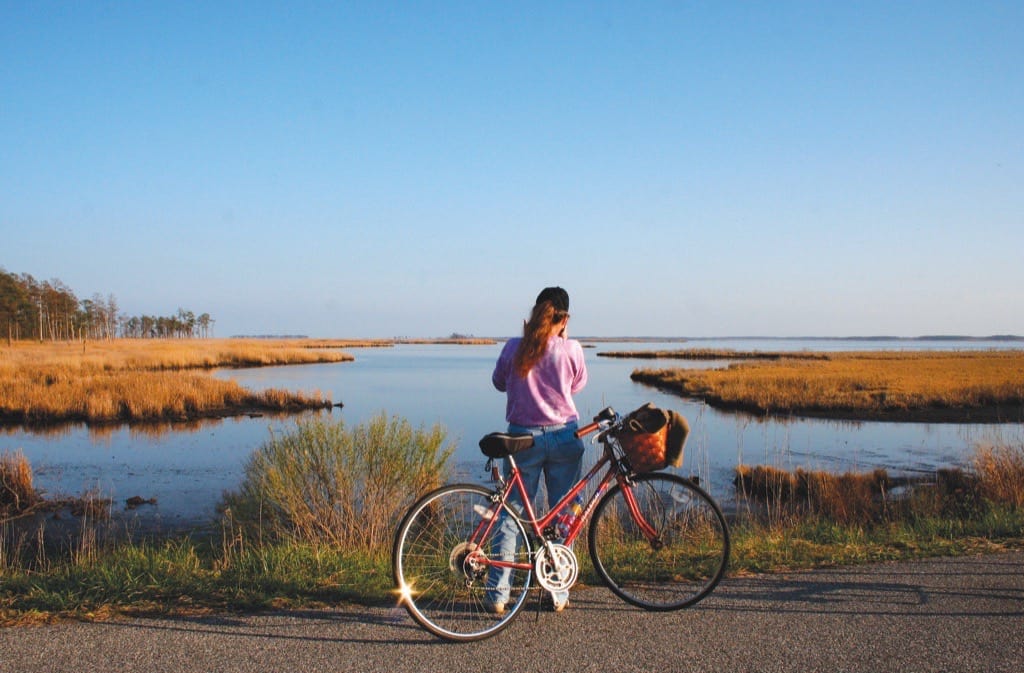Ambling after trout is good for the soul.
By Captain Chris D. Dollar
For anglers looking for an alternative to spring-run stripers, this is a glorious time for meandering in and along trout streams. We are fortunate here on the Chesapeake to have the choices in such close proximity. Our state and national parks explode with wild blooms, and many of the region’s myriad streams run cold and clear.
I’m no trout fishing expert by anyone’s standard, but I know of no better way to calm the angst of a world gone mad than to fish the Bay’s headwater streams for trout. There’s a thrill in just getting to these kinds of places, bouncing along off-road trails and up rock-strewn gullies.
Some years back, I traveled to the mountains for a weekend of fishing and camping with a friend who was disentangling himself from a marriage that was doomed from the start. He needed this trip more than I did, and I needed it badly. The day broke gorgeously with crisp mountain air seeping through a canopy of trees lining the Casselman River near Grantsville, Maryland. Where the river flows south to north across the Pennsylvania line, we discovered that we were straddling the Mason-Dixon line, the famed boundary drawn to settle the land dispute between the Penn and Calvert families.
That afternoon, the fish were cooperative, and in a secluded spot with fast-flowing riffles and good pools, a wooly-bugger fly fooled some rainbow trout and even a few smallmouth bass. When clouds rolled in and charged the air with electricity, standing the hair on my arms on end, we reluctantly got off the water. My friend’s troubles hadn’t disappeared, but he at least he felt recharged. And so did I.
No question, the Bay watershed has lots of places to fish for trout, more than one angler could fish in a lifetime. I may be biased, but my home state of Maryland, known mostly for the stripers and crabs, has impressive trout options. Formed from the cold-water Alleghany Mountain springs, the Savage River is one of Maryland’s top fishing destinations for native, wild brook and not-native brown trout. I used to camp twice a year at Savage River State Park, which, at 54,000 acres, is the largest park in the state forest system. Poplar Lick and Big Run were two of my favorite places to prod the pockets for not-so-wise trout.
According to Maryland’s Sport Fisheries Advisory Commission chairman and Trout Unlimited life member John Neely, there is good news about the future of wild trout in western Maryland.
“The upper Savage River drainage is the largest intact wild trout habitat south of Maine. With 120 miles of interconnected streams, it supports a healthy population of Maryland’s only remnant fish from the last ice age, the wild brook trout,” he says. Biologists estimate that adult trout densities measure roughly 1,000 fish per mile throughout most of the river. Although brown trout dominate the stream, there are plenty of brookies.
Neely goes on to explain that, almost twenty years ago, Maryland joined other eastern states to undertake a brook trout initiative that called for the use of artificial lures and flies and catch-and-release only in designated stretches (special management areas) of the Savage River watershed and other sensitive trout areas such as the upper stretch of the North Branch of the Potomac.
“Because of these conservation measures, there has been strong recruitment in young-of-year and
the population has taken off,” he says. “Tributary streams to the Savage River, such as Poplar Lick,
Big Run, Middle Fork and to a lesser extent Dry Run regularly support 1,200 to 1,400 wild brook trout per mile. And it’s not uncommon now to catch 10- to 12-inch brookies.”
While the Savage River brook trout resurgence has sweetwater anglers amped, both the upper Casselman and Youghiogheny river trout populations are also improving. Decades of work by the Maryland Department of Natural Resources, the Maryland Department of the Environment, and the Youghiogheny River Watershed Association to redeem the Casselman River watershed in Garrett County is paying off. Today, this tributary, once awash in chemical pollutants from abandoned coal mines, which nearly wiped out the brook trout population, is healthier and getting stronger.
It’s true that not everyone fishes (heathens), but we all require clean drinking water. Efforts on the federal level to ease regulations could taint water supplies and unbutton years of work that restored these pastoral regions of the Bay watershed. Environmental and conservation groups, working with public agencies, have planted riparian buffers of native hardwoods, cool-season and warm-season grasses and shrubs, which help reduce harmful nutrient and sediment pollution that enters the streams and creeks.
Keeping wild places wild also provides the bonus of incredible wildlife sightings. I recall a float trip down the Shenandoah River and being mesmerized by river otters, their dark-brown coats shimmering
in the sun’s rays. Amiable and fun-loving swimmers, they’re a treat to see in their natural environs.
Other outings revealed a Baltimore oriole and different types of swallows, including the tree swallow with its beautifully iridescent head.
My buddy Jeff Lewandoski operates Gunpowder River Angler and is spot-on when he tells me that fly fishing for freshwater trout “tests an angler’s instincts and requires patience and finesse. The slightest differences in approach, presentation, and choice of techniques can be the difference between just fishing or catching.”
Few things spark greater joy than walking a trout stream and matching wits with wild trout sheathed in wilderness. It helps keep melancholy at bay. I can fish with riveted focus or simply let my thoughts float downstream, and no one can tell the difference. Sometimes neither can I, and perhaps that’s the best part.




